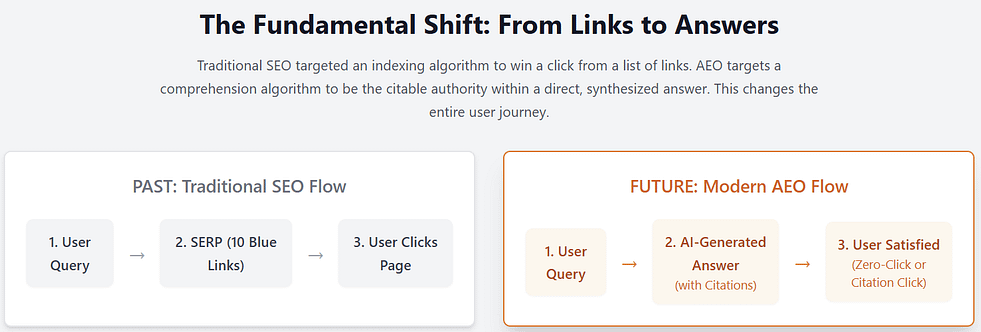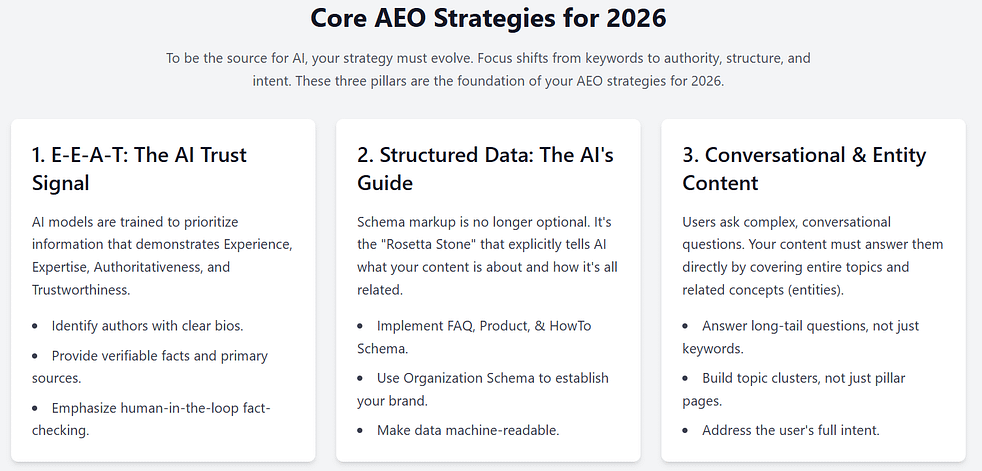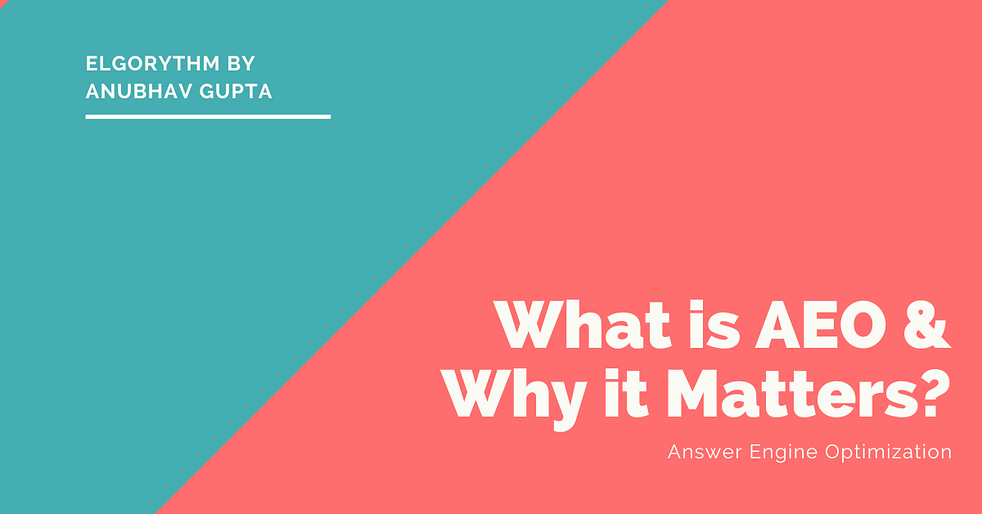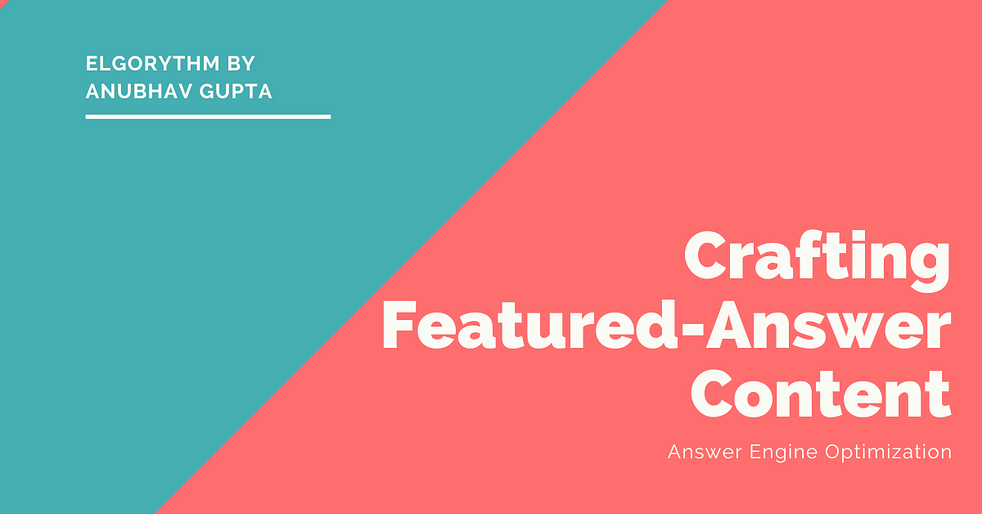The digital landscape is undergoing a foundational transformation driven by artificial intelligence (AI). For decades, success in search engine optimization (SEO) was defined by securing the coveted number one ranking—the highest clickable link on the search engine results page (SERP). That era is rapidly concluding. The new competitive imperative is Answer Engine Optimization (AEO), a strategic model focused not on generating clicks, but on becoming the authoritative response that AI models cite directly.1
By 2026, brands must fully integrate AEO into their digital strategies to navigate the “zero-click” reality, where users receive synthesized, definitive answers without ever visiting a website. This requires a nuanced understanding of how Large Language Models (LLMs) operate, what content they trust, and how to effectively measure AEO performance across a fragmented AI landscape.
I. The Zero-Click Reality: Why AEO is the New Search Imperative
The shift from traditional search engine rankings to generative AI summaries is the single greatest catalyst for the evolution of digital visibility. AEO is fundamentally the practice of aligning a brand’s technical and content strategy to minimize user effort by providing clear, direct answers.3 This necessity is driven by the rise of pervasive, multi-platform discovery—from smart speakers to mobile answer engines and chatbots like ChatGPT—where the user expectation is instant, curated information, not a directory of links.4

The Data Driving the Transformation
The data collected throughout 2025 unequivocally demonstrates the urgency of adopting AEO strategies 2026. Zero-click searches, where users find their answer directly on the SERP without clicking through to a source, now account for 58% of all Google searches.6 This phenomenon dramatically undercuts the effectiveness of traditional click-based SEO models.
The launch and expansion of AI Overviews (AIOs) exacerbate this issue. A study tracking organic click-through rates (CTR) revealed a severe impact when AIOs appeared. For keywords that triggered an AI Overview, the average CTR for the traditional position one listing plummeted from 7.3% to a mere 2.6%.7 This massive dilution of organic traffic volume signifies that reliance on last-click attribution models is no longer viable. Marketers must transition from measuring click conversion to tracking influence conversion—quantifying how often a brand’s authority is leveraged by AI before a high-intent user converts later, thereby justifying the shift to new metrics designed to measure AEO performance.1
As one industry expert noted: “Being findable isn’t enough anymore. In the era of AI, you must be the response”.2 This powerful statement summarizes the current competitive landscape: mere existence on the SERP is insufficient; the brand must possess the authority and structure to be selected by the AI as the source of truth.
II. Deciphering AEO Strategies 2026: The Holistic Optimization Model
For 2026, the successful optimization strategy is not singular but synergistic, requiring the coordinated deployment of three interdependent models: SEO, GEO, and AEO.
Q: What is the relationship between SEO, GEO, and AEO in 2026?
A: Traditional SEO (Search Engine Optimization) is the essential foundation, focusing on site health, technical soundness, and establishing credibility through E-E-A-T (Experience, Expertise, Authoritativeness, and Trustworthiness). GEO (Generative Engine Optimization or Geographical Optimization) layers local relevance and context, crucial for the increasing volume of voice and ‘near me’ queries. AEO (Answer Engine Optimization) is the tactical layer that restructures content using schema and Q&A formats to ensure the authoritative information, discovered by SEO, is synthesized and cited by AI models into direct, concise answers.4
The Strategic Pillars for AEO
The cornerstone of modern AI-driven search optimization is the recognition that content must be machine-readable. A technically sound website is a non-negotiable prerequisite, as LLMs cannot leverage disorganized or ambiguous content.9
AEO strategies 2026 mandate two key strategic shifts in content creation:
Intent-Centric Design: Content strategy must move decisively from a keyword-centric approach (“What keyword should I target?”) to an intent-focused mindset (“What question is the user trying to answer?”).5 This shift facilitates conversational, question-based content that aligns perfectly with how users engage with voice assistants and chatbots.
Semantic Optimization: LLMs thrive on content that is semantically rich and contextual.9 Successful AEO requires moving beyond mere keyword saturation to embracing deep semantic relationships and entity understanding.11 The competitive edge in 2026 rests on rigorous technical implementation and clear site hierarchy, ensuring the content is structurally sound enough for accurate AI extraction.
The Local Imperative: Synergy with GEO
Generative AI often incorporates localized context, making the integration of GEO critical for many businesses. Voice searches and mobile answer engines frequently include location-specific queries, such as, “Where can I get vegan food in Delhi?”.10
For localized AI-driven search optimization, the combination of GEO and AEO ensures that AI results provide contextually relevant answers.13 Actionable GEO tactics for 2026 include rigorously claiming and optimizing the Google Business Profile, integrating local keywords into content, and actively encouraging local reviews and ratings to boost credibility within localized knowledge graphs.10 Entity optimization must include consistent mentions of the brand and its specific location (e.g., Sarasota, FL) to solidify local authority within the AI model’s knowledge base.14
III. Mastering AI-Driven Search Optimization: Trust and Technicality
Success in the age of generative search hinges on understanding the underlying technology: Retrieval-Augmented Generation (RAG).
Understanding the AI Plumbing: RAG and Citation
AI-driven search optimization platforms, including Google’s AI Overviews, rely on RAG systems.15 These systems function by retrieving knowledge from external sources (the open web) and synthesizing that information with the LLM’s existing training to produce a coherent and authoritative response.15 Crucially, RAG outputs often provide citations, similar to academic references, directly linking the synthesized answer back to the source material.15 Earning this citation—or ‘attribution’—is the core tactical goal of AEO.
The E-E-A-T Firewall: Building Authority
AI engines, recognizing the need for factual accuracy and credibility, prioritize high-quality, trustworthy sources for RAG retrieval.16 This is where Google’s E-E-A-T framework becomes foundational to AEO. E-E-A-T—standing for Experience, Expertise, Authoritativeness, and Trustworthiness—acts as the quality check that determines if content is reliable and credible enough for an AI system to cite.17
In this model, E-E-A-T determines eligibility for AI citation, while the technical AEO strategies 2026 determine selection within the eligible content pool.17 Without established high E-E-A-T, specialized AEO tactics are unlikely to yield results. Furthermore, the content strategy must prioritize educational value over sales messaging, as AI systems tend to filter out overtly promotional content.18 The ultimate competitive advantage in the AI era is offered by proprietary studies, original research, and first-party data, which provide unique insights that generalized AI summaries cannot replicate.12 This focus on unique content builds the trust rewarded by high citation frequency.

Schema Markup: The Foundation of Machine Readability
Strategic structured data implementation, or Schema Markup, is no longer a supplementary tactic; it is foundational to successful AI-driven search optimization.12 Schema, which includes markups like FAQs, How-Tos, Knowledge Base, and VideoObject, helps AI models interpret the site’s hierarchy, purpose, and content context.14
Analysis of implementation challenges consistently reveals that poor or incomplete structured data prevents AI systems from accurately understanding and citing content.18 Therefore, advanced schema implementation is a core prerequisite. It provides the necessary roadmap for LLMs to extract precise, verifiable facts from credible sources, making technical SEO and E-E-A-T inseparable prerequisites for effective AEO.
IV. Content Engineering: The Formats That Drive AI Citations
Effective AEO strategies 2026 require a fundamental redesign of content structure, moving toward an “answer-first” architecture optimized specifically for machine extraction.
The “Answer-First” Architecture Mandate
The primary content mandate is conciseness and clarity. To increase the likelihood of securing featured snippets and being extracted by an LLM, the core, direct answer should be delivered within the first 40 to 50 words of a content section.6 This Q&A style mirrors the conversational nature of AI interaction.5 Optimizing for featured snippets (often referred to as Position Zero) and People Also Ask (PAA) sections remains crucial, as these elements are frequently used as input sources for generative AI responses.3
As the philosophy of one leading AEO platform suggests, “Today’s customer prefers answers, not links”.21 This preference necessitates a content strategy that prioritizes instant utility.
Strategic Content Format Selection
Not all content formats are equally effective in generating AI citations. Data analysis reveals distinct preferences among AI engines based on how readily they can extract clear, discrete facts and structured comparisons.
The table below outlines the citation performance based on extensive analysis of 2.6 billion citations across AI platforms 8:
AI Citation Performance by Content Format (Sept 2025 Data)
Content Type | % Share of AI Citations | AEO Strategy Implications |
Comparative/Listicle | 25.37% | Highest priority for authoritative, easily parsed summaries. |
Blogs/Opinion | 12.09% | Valuable for thought leadership and contextual depth. |
Documentation/Wiki | 3.87% | Essential for factual, proprietary, or technical information. |
Commercial/Store | 3.82% | Requires specific product schema and clear Q&A content. |
1.74% | Low general citation rates, but rising rapidly in “How-To” queries. |
The overwhelming dominance of Comparative/Listicle content (accounting for over 25% of all citations) is highly revealing. It confirms the LLMs’ inherent preference for structured data sets, comparisons, and numbered facts that can be easily synthesized into a coherent, cited answer. This structural reliability dictates that comparison pages and listicles should be prioritized in AEO strategies 2026.
The optimal approach combines the best of both worlds: provide a direct, concise answer first to capture the AI citation, followed by detailed, long-form content to establish credibility and topical authority for human readers.22 Winning high-value traffic means providing a level of detail and expertise that a general AI summary simply cannot replicate.23
V. How to Measure AEO Performance in a Zero-Click World
The adoption of AI-driven search optimization requires a parallel evolution in accountability metrics. Traditional KPIs are no longer sufficient when 37% of product discovery queries now originate directly in AI interfaces like ChatGPT and Perplexity.8
The Shift to Visibility and Prominence
Since traditional metrics like organic CTR and impressions fail to capture success in a zero-click environment 1, the new focus must be on brand visibility, prominence, and positive sentiment within AI-generated responses.1 The solution is the AEO (Answer Engine Optimization) score, which quantifies how often and how prominently AI systems cite a brand in their generated responses.8
To effectively measure AEO performance, a proprietary model developed through research analyzed 2.6 billion citations to define the key weighted factors influencing AI citation success.8
Key Weighted Factors in the AEO Score Model
AEO Factor | Weight (%) | Definition and Rationale |
Citation Frequency | 35% | The raw share of AI-generated answers citing the brand (direct visibility across platforms). 8 |
Position Prominence | 20% | Whether the citation appears in the top visual placement of the AI response (quality and authority signal). 8 |
Domain Authority | 15% | Scaled DA factoring in AI citation context (source credibility and trust). 8 |
Content Freshness | 15% | Recency of the last crawl by AI models (relevance and timeliness). 8 |
Structured Data | 10% | Correct implementation of schema.org markup (machine readability). 8 |
Security Compliance | 5% | SOC 2, GDPR, HIPAA readiness (source security and trust). 8 |
This weighting reveals that Citation Frequency (35%) is the most important factor, validating that direct visibility is the most valued output of AEO strategies 2026. Furthermore, the inclusion of Security Compliance (5%) underscores a broader industry implication: as AI systems ingest web data for their answers, the trustworthiness of the source extends to its security posture. For B2B and regulated industries, AEO thus becomes a critical IT security and compliance concern, not merely a marketing endeavor.8
Tools and Cross-Platform Tracking
Effective AI-driven search optimization necessitates cross-platform monitoring. Tools must analyze brand visibility, sentiment, and competitive positioning across leading AI systems, including GPT-4o, Perplexity, Gemini, and Google AI Overviews.8 Cross-platform tracking is vital because citation patterns differ significantly; for example, YouTube is cited 25% of the time in Google AI Overviews when a link is present, but less than 1% of the time by ChatGPT, indicating major differences in RAG implementation.8

VI. Global Visibility and Local Relevance: The GEO-AEO Nexus
While AI usage often correlates strongly with income globally, emerging economies present massive growth opportunities that demand localized AEO strategies 2026. For instance, countries like India show lower initial per-capita usage of AI platforms (0.27x expected).25 However, the Indian AI market is projected to reach $8 billion by 2025, growing at a CAGR exceeding 40%.26
This explosive market potential signals a crucial early-mover advantage for brands that prioritize effective AI-driven search optimization now. The massive and growing digital infrastructure in this region suggests that investment in GEO and AEO alignment will translate directly into future market dominance.
For organizations targeting these regions, the strategic emphasis must be on conversational, localized content. Specific GEO optimization tactics must include rigorous Google Business Profile optimization and utilizing FAQ schema to structure local content that directly answers location-specific questions (e.g., “best service provider in”), making the content machine-readable for local generative responses.10 The competitive differentiator in the future will be optimization for vernacular and multilingual content, ensuring that local entity management is prepared for deeper LLM integration across diverse languages.
VII. Conclusion: Future-Proofing Your Brand in the Age of Answers
The transition to an answer-first web is irreversible. By 2026, brands that remain rooted in traditional keyword ranking and click-through metrics will face severe organic visibility decline. The future of search belongs to those who shift their strategy from simply “ranking websites” to truly “becoming the answer”.3
The mandate for digital success involves three non-negotiable strategic shifts:
Trust and Authority: Invest heavily in E-E-A-T credentials, security compliance, and robust technical schema to establish eligibility for AI citation.
Structured Answers: Restructure content using an answer-first architecture and prioritize formats like listicles to ensure immediate machine extraction and high citation frequency.
Accountability: Adopt the AEO Score and its component metrics to effectively measure AEO performance beyond traditional click volume, focusing instead on prominence and influence across critical AI platforms.
By integrating these specialized AEO strategies 2026 with fundamental SEO and crucial GEO tactics, businesses can ensure long-term, authoritative visibility in the complex world of AI-driven search optimization.
Frequently Asked Questions (FAQs)
1. What are the biggest challenges when implementing AEO strategies 2026?
The primary hurdle for many organizations is technical complexity. Implementing correct and complete structured data and schema markup often demands specialized technical expertise, which can be a substantial requirement for smaller businesses.19 Other significant challenges include maintaining consistent information across a brand’s entire content ecosystem, which is vital for AI systems that value accuracy, and avoiding an overtly promotional content focus, as AI platforms prioritize educational value and objectivity.18
2. How do I ensure my content is not filtered out by AI Overviews?
To avoid being filtered out by AI systems, content must demonstrate high E-E-A-T (Experience, Expertise, Authoritativeness, and Trustworthiness). AI systems actively filter out content that appears low-credibility or overly promotional.16 The strategy must focus on establishing comprehensive topical authority rather than optimizing isolated pages for narrow keywords. High-quality, factual, and trustworthy content is the entry ticket for AI citation.
3. Is AEO just another name for advanced SEO?
No. While AEO requires strong traditional SEO fundamentals (E-E-A-T, technical health), AEO specifically focuses on optimizing the content structure and data presentation for consumption by AI models, aiming for a direct citation in a zero-click result.22 Traditional SEO aims to rank higher on a list of links; AEO aims to be the single, synthesized response.28 The two strategies are complementary but distinct in their tactical goals.
Works cited
- How to Know if Your SEO Agency Can Help You with AEO, accessed on October 24, 2025, https://learn.g2.com/tech-signals-how-to-know-if-your-seo-agency-can-help-you-with-aeo?hsLang=en
- Why AEO Is The Future Of SEO And How To Master It – Forbes, accessed on October 24, 2025, https://www.forbes.com/councils/forbesagencycouncil/2025/08/29/why-aeo-is-the-future-of-seo-and-how-to-master-it/
- Answer Engine Optimization (AEO): SEO Strategy You Can’t Ignore in 2025-2026 – ITXITPro, accessed on October 24, 2025, https://itxitpro.com/blog/answer-engine-optimization-aeo-seo-strategy-you-cant-ignore
- SEO vs. GEO vs. AEO: An Ultimate Guide to Rank Everywhere – Magneto IT Solutions, accessed on October 24, 2025, https://magnetoitsolutions.com/blog/seo-vs-geo-vs-aeo
- Why AEO is the Future of SEO – eSEOspace, accessed on October 24, 2025, https://eseospace.com/blog/why-aeo-is-the-future-of-seo/
- TOP FEATURED SNIPPET STATISTICS 2025 – Amra & Elma, accessed on October 24, 2025, https://www.amraandelma.com/top-featured-snippet-statistics/
- 47 AI Overviews Statistics (2025) – Adoption, Traffic & Trends – Demand Sage, accessed on October 24, 2025, https://www.demandsage.com/ai-overviews-statistics/
- 9 AI Visibility Optimization Platforms Ranked by AEO Score (2025), accessed on October 24, 2025, https://nicklafferty.com/blog/best-ai-visibility-optimization-platforms/
- Future SEO 2026 AEO GEO LLM & Semantic Traditional Synergy | Udaipur Freelancer, accessed on October 24, 2025, https://udaipurfreelancer.com/blog/future-seo-in-2026/
- AEO, SEO & GEO: The Ultimate Guide to Modern Search Optimization, accessed on October 24, 2025, https://richclickstechnology.in/aeo-seo-geo-guide/
- Practical AEO Strategies for 2025: SEO That Answers with Authority – INSIDEA, accessed on October 24, 2025, https://insidea.com/blog/seo/aeo/aeo-strategies/
- Tailoring Your SEO Strategy for AI Optimization: A Practical Guide for Implementing an AEO Strategy | Corkboard Concepts, accessed on October 24, 2025, https://corkboardconcepts.com/marketing-resources/articles/tailoring-your-seo-strategy-for-ai-optimization-a-practical-guide-for-implementing-an-aeo-strategy/
- Tips on how to start working on GEO, AEO for my SaaS product. : r/DigitalMarketing – Reddit, accessed on October 24, 2025, https://www.reddit.com/r/DigitalMarketing/comments/1n6fp0d/tips_on_how_to_start_working_on_geo_aeo_for_my/
- From SEO to AEO (Answer Engine Optimization): How AI is Redefining Client Acquisition, accessed on October 24, 2025, https://blog.nextinymarketing.com/seo-vs-aeo-ai-answer-engine-optimization
- Understanding RAG and SEO: The Future of Generative AI – Trust Signals, accessed on October 24, 2025, https://www.trustsignals.com/blog/understanding-rag-and-seo-the-future-of-generative-ai
- AI Presents: The Future of Search – LLMs, AI Search & Optimization Strategies – Reforge, accessed on October 24, 2025, https://www.reforge.com/blog/the-future-of-search-llms-ai-search-and-optimization-strategies
- E-E-A-T as a Ranking Signal in AI-Powered Search – The ClickPoint Blog, accessed on October 24, 2025, https://blog.clickpointsoftware.com/google-e-e-a-t
- Answer Engine Optimization FAQ: Your Complete AEO Guide – eSEOspace, accessed on October 24, 2025, https://eseospace.com/blog/faq-aeo/
- Pros and Cons of Implementing Answer Engine Optimization (AEO), accessed on October 24, 2025, https://anytimedigitalmarketing.com/2024/12/26/pros-and-cons-of-implementing-answer-engine-optimization-aeo/
- AEO: How To Optimize Content for Answer Engine Optimization – AirOps, accessed on October 24, 2025, https://www.airops.com/blog/aeo-answer-engine-optimization
- 10 Best Answer Engine Optimization (AEO) Tools Personally Tested & Reviewed [July 2025], accessed on October 24, 2025, https://writesonic.com/blog/answer-engine-optimization-tools
- AEO vs. SEO: Key Differences, Benefits & Strategies for 2025 – SeoProfy, accessed on October 24, 2025, https://seoprofy.com/blog/aeo-vs-seo/
- Answer Engine Optimization (AEO): A Strategic Framework for Winning in AI Search in 2025, accessed on October 24, 2025, https://thedigitalelevator.com/blog/answer-engine-optimization-aeo/
- AEO Grader – 2025 – HubSpot, accessed on October 24, 2025, https://www.hubspot.com/aeo-grader
- Anthropic Economic Index report: Uneven geographic and enterprise AI adoption, accessed on October 24, 2025, https://www.anthropic.com/research/anthropic-economic-index-september-2025-report
- India Artificial Intelligence – International Trade Administration, accessed on October 24, 2025, https://www.trade.gov/market-intelligence/india-artificial-intelligence
- From SEO to AEO: Why Businesses Must Adapt to AI-Driven Mentions – Social Buzz, accessed on October 24, 2025, https://socialbuzz.org.in/seo-to-aeo-future-of-search/
- The New Language of Search: SEO, AEO, GEO, SEO 2.O and Beyond in 2026, accessed on October 24, 2025, https://www.smoothfusion.com/blog/post/the-new-language-of-search-seo-aeo-geo-in-2026




